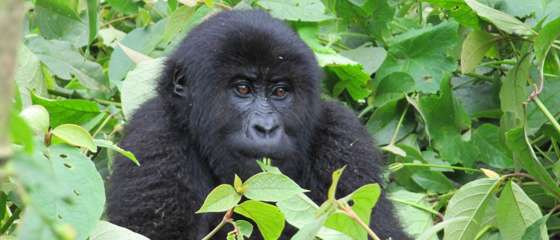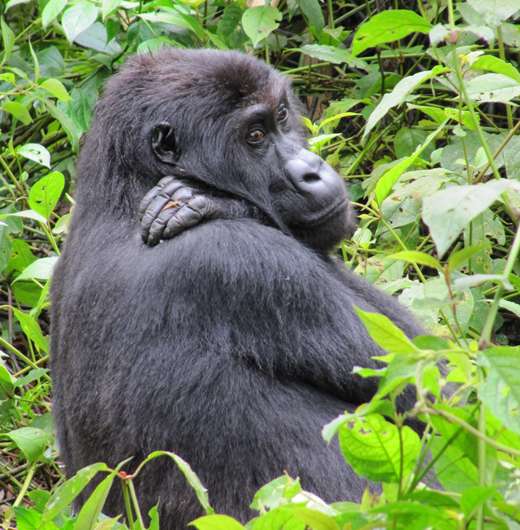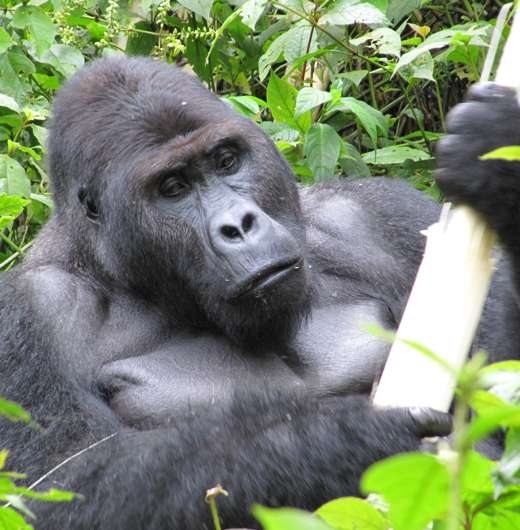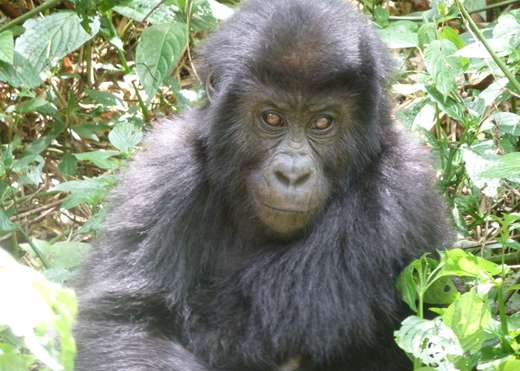New study documents shocking collapse of gorilla subspecies during 20 years of civil unrest

A shocking new report by Fauna & Flora International and the Wildlife Conservation Society (WCS) documents a catastrophic collapse of the world's largest primate – the Grauer's gorilla – due to a combination of illegal hunting, civil unrest, and habitat loss from mining.
The results of the report point to a 77% drop in gorilla numbers, from an estimated 17,000 in 1995 to just 3,800 individuals today. Grauer's gorillas – the world's largest gorilla subspecies weighing up to 400 pounds – are closely related to the better known mountain gorilla. The subspecies is restricted to eastern Democratic Republic of Congo (DRC).
ICCN, WCS, Fauna & Flora International and other partners are calling for the following additional actions to reverse the decline of Grauer's gorillas:
- Legally gazette the boundaries of Itombwe Reserve and Punia Gorilla reserve
- Tackle illegal mining inside protected areas and pursue the legal establishment of artisanal mining cooperatives in areas close to gorilla habitats
- Disarm militia groups operating in the region
- Support park staff and community ecoguards that they are protecting gorillas and their habitat
- Find alternative sources of income for local people other than employment from mining
- Lobby mobile phone/tablet/computer companies and others to ensure that source minerals from this region are purchased from mining sites that do not hunt bushmeat and are conflict free
The research design was led by experts from Fauna & Flora International and WCS, with data gathered from across the Grauer's gorilla range by a group of collaborating organisations. The report, funded by ARCUS Foundation analysing data collected with support from Critical Ecosystem Partnership Fund, KfW (German Development Bank), ICCN, Newman's Own Foundation, Rainforest Trust, UNESCO, USAID, US Fish and Wildlife Service and World Bank was presented at a press conference in Kinshasa.

The authors of the report say that their findings justify re-categorising the Grauer's gorilla as Critically Endangered on the IUCN Red List of Threatened Species, highlighting the perilous position these great apes are in, and the need to act now to prevent a further decline in numbers. This would put all four gorilla subspecies in the Critically Endangered category.
Casualties of war
The decline in Grauer's gorillas can be traced back to the Rwandan genocide in 1994, which forced hundreds of thousands of refugees to flee to the DRC. This in turn led to the DRC civil war in 1996, which continued until 2003 with devastating consequences, including an estimated 5 million people killed. But beyond the human tragedy, the war has also taken its toll on the DRC's wildlife as a result of insecurity, heightened illegal bushmeat trade and increased deforestation.

The authors of the report sought to assess the impact of the civil war on Grauer's gorilla numbers, which were estimated at 17,000 before the conflict. Field teams conducted widespread surveys, the most intensive ever for this ape, in regions beset by insecurity, searching for ground nests and other signs of this elusive ape. In addition, the authors employed a novel method that allowed them to rigorously assess data collected by local community members and rangers to estimate Gorilla abundance.
The survey results confirmed their worst fears: numbers had plummeted to an estimated 3,800 individuals – a shocking 77% decline.
One of the primary causes of the decline in Grauer's gorilla numbers has been the expansion in artisanal mining for coltan (a key mineral used in the manufacture of mobile phones and other electronics) and other minerals in the gorilla's range. Most of these artisanal mining sites are remote, which means that the miners often turn to local wildlife for food. Although protected by law, gorillas are highly prized as bushmeat due to their large size and because they are easily tracked and killed as they move in groups on the ground in their small home ranges.
Turning the tide

The authors say that halting and reversing the decline of Grauer's gorilla will take considerable effort and will require more funding than is currently available. Artisanal mining must be controlled and the various armed groups that control mines disarmed. To accomplish this, it will be necessary to halt mining in protected areas, as it is known that miners subsist on bushmeat and hunt gorillas around their camps.
Three areas are now particularly crucial for the gorilla's survival: Kahuzi-Biega National Park, the adjacent Punia Gorilla Reserve, and the remote unprotected Usala Forest which has no support currently. The Itombwe Reserve and the Tayna regions also support highly-important outlying populations. It is critical to formally gazette the Itombwe and Punia Reserves, which have community support but are not yet legally established.
"We urge the government of DRC to actively secure and manage this part of the country for both human welfare as well as the survival of this gorilla," said the study's lead author Andrew Plumptre of WCS. "Significantly greater efforts must be made for the government to regain control of this region of DRC. In particular, the government needs to quickly establish Reserve des Gorilles de Punia and the Itombwe Reserve, and reinforce Kahuzi-Biega National Park efforts, which have community support, and to establish strong coordination between ICCN and the DRC military to tackle armed militias that control mining camps in Grauer's gorilla heartland."
Stuart Nixon of Fauna & Flora International (now at Chester Zoo where he has continued his analysis of the survey data), one of the co-authors involved in the study stated, "Grauer's gorilla is found only in the eastern Congo – one of the richest areas on our planet for vertebrate diversity. As one of our closest living relatives, we have a duty to protect this gorilla from extinction. Unless greater investment and effort is made, we face the very real threat that this incredible primate will disappear from many parts of its range in the next five years. It's vital that we act fast."
Radar Nishuli, Chief Park Warden for the Kahuzi Biega National Park and another co-author, said: "What we have found in the field is extremely worrying. We are urging a strong and targeted response that addresses the following: Train, support and equip ecoguards to tackle poaching more effectively; build intelligence networks, and support the close daily monitoring of gorilla families to ensure their protection; engage customary chiefs who hold traditional power in the region to educate their communities to stop hunting these apes."
Jefferson Hall, staff scientist at the Smithsonian Tropical Research Institute and another co-author, said: "The bright spot in all this is that we have seen, over and over again, dedicated Congolese conservationists risk their lives to make a difference," said Hall. "Thanks to these individuals, there is still hope and the opportunity to save these animals and the ecosystems they represent."
Provided by Fauna & Flora International




















